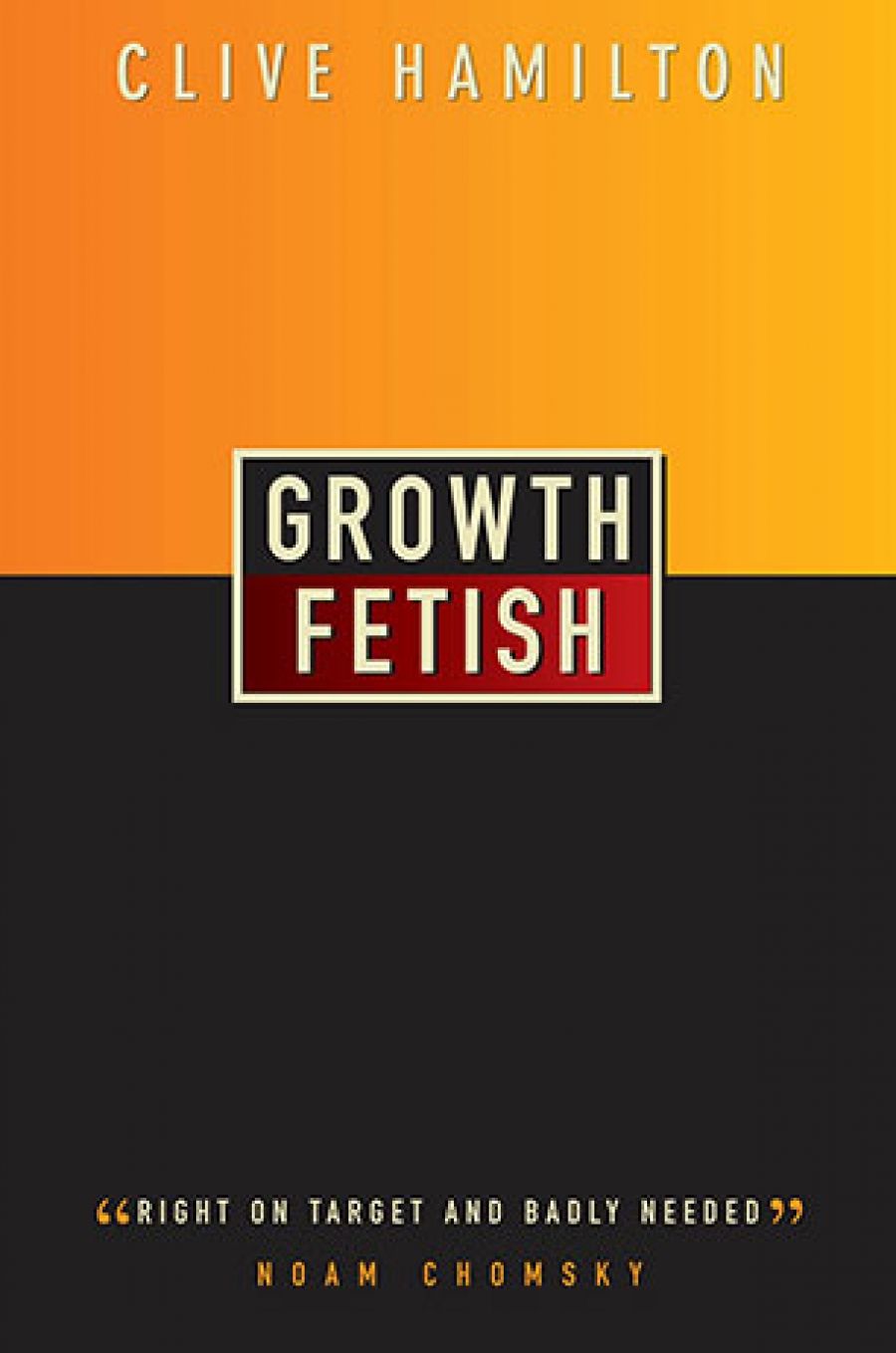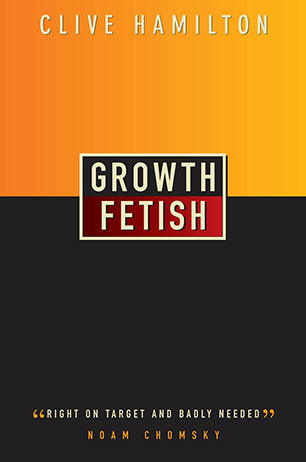
- Free Article: No
- Contents Category: Economics
- Review Article: Yes
- Article Title: Get Happy
- Online Only: No
- Custom Highlight Text:
The cover is spare, the title centre-boxed in a subtle reprise to No Logo, and it is all bound together with a plug by Noam Chomsky. That’s some savvy marketing, designed to appeal to anti-globalisers and bobos alike. Yessir, capitalism works. It co-opts and it commodifies. Even ideas are not immune. It is the policy prescription and its ‘spin’ that are sold. Thinktanks, whose business it is to peddle ideas, are constantly mired in the contradiction between clear-eyed analysis, the basis of their credibility, and advocacy, the basis of their influence. In Growth Fetish, the balance weighs too heavily towards advocacy and the reader is left feeling slightly conned, much like Clive Hamilton reckons we feel each time we depart from the shopping mall.
- Book 1 Title: Growth Fetish
- Book 1 Biblio: Allen & Unwin, $24.95pb, 279pp
- Book 1 Cover Small (400 x 600):

- Book 1 Cover (800 x 1200):

Hamilton is the director of the Australian Institute, a left-wing thinktank based in Canberra. Whatever views one might have about the Institute’s stance, it has succeeded in being a consistent irritant in the side of that other mob in Canberra. It has been the leading exponent in favour of Australia signing the Kyoto Protocol, has exposed inequities in the private health insurance rebate, and caused a major stir about academic standards in universities.
Much of the content of this book has previously appeared in various Australian Institute guises – speeches, newsletters and discussion papers. Consequently, it has something of a collected essays feel to it. Some of the seam stitching is too visible, while other parts are padding.
The essence of the argument is that rising living standards in the post-World War II period have not made us any happier. What has risen over the period is environmental degradation, income inequality, drug abuse and obesity. This is by no means a novel argument. In the early 1970s the Club of Rome predicted an environmental catastrophe by century’s end unless economic growth was attenuated. Fred Hirsch, in Social Limits to Growth (1976), took a more nuanced line. It was not environmental constraints that would limit growth; instead, argued Hirsch, people would gradually realise the futility of besting one’s neighbours in the consumption of ‘positional goods’. If happiness has not moved on, neither, it would seem, has the debate.
What do we mean when we talk about happiness? In 1970 local fans of football’s World Cup were reduced to reading the fine print in their morning newspaper to learn that Brazil had defeated Italy, in what has gone down in lore as one of the greatest games ever. During the 2002 World Cup, every game was beamed live to homes and pubs across the country, thanks largely to SBS (god bless ’em). Ephemeral? Well, of course, but the sheer joy of watching the South Koreans disposing of Portugal, Italy and Spain enlivened office kitchen and factory floor talk for a month.
Happiness is always relative. When we are interrupted in the throes of our evening meal by a telephone call from a market research agency (‘Just wanting to ask you a few questions about your current life satisfaction, sir’), I daresay it is unlikely that we will recall that in 1970 we could not watch the World Cup on television.
Let us say, even if Hamilton’s evidence is thin – curious that there is no reference at all to Robert Lane’s The Loss of Happiness in Market Democracies (2000) – that he is right and that we are, on average, no happier now than we were in 1970, satellite television broadcasts notwithstanding. As I see it, even proceeding from this stylised fact, there are three major problems with Hamilton’s treatment of it.
The first is that, on bare objective measures, life keeps getting better, at least for some groups. In 1900 the average Australian woman married in her teens after no more than a handful of years of schooling, bore four children and lived to her mid-fifties in penury with a husband who could, by law, treat her as chattel. One hundred years later, she had gone on to Year 12, if not to university, and had made real choices about the kind of work she might do, whether to get married, and if she should have children at all. In all likelihood, she would live beyond eighty. According to Hamilton, women have got equality but not liberation, ‘unfettered opportunity … to create themselves in the images invented for them by the marketers’. Call me churlish, but I am sure most women would prefer to have that opportunity than none at all.
A second is Hamilton’s treatment of a loss in happiness as something that applies to the population as a whole, rather than the sum of differences across that population. My hunch would be that the élites, who have been the principal beneficiaries of economic ‘reform’, are rather more content with their lot than the ‘mums and dads’ with their gyrating Telstra holdings, let alone those who have been downsized out of a job and onto a mutual obligation programme. Part of the endurance of neo-liberal policies must be a conviction that they work, for at least a sizeable minority of people. That is why they are supported by both major political parties and, in general, by opinion leaders. Unpacking the winners and losers, as Michael Pusey goes some way towards in The Experience of Middle Australia: The Dark Side of Economic Reform (2003), is necessary if we are to understand why we might persist with policies that cause some people unhappiness.
The third flaw is that Hamilton is obsessed with consumption, and that distracts him from examining the process of production. Most of us have dual roles as producers and as consumers. For the most part, we (happily) purchase the best-value goods without much regard to the human ingredients that enter the soup. In the main, this is information the market does not provide – largely, I suspect, because it would be entering territory where we prefer not to go. On the one hand, we routinely bemoan casualisation of jobs and unsociable working hours, while on the other wanting the convenience of stepping out late at night to replenish, say, one’s supply of lentils. In Pusey’s resonant phrase, this is tantamount to ‘eating yourself’. Hamilton has largely overlooked this fundamental dissonance in our dual roles and missed most of the explanation for whatever loss of well-being has occurred.
There is one other element of this book that is deeply off-putting. Hamilton shares with Tony Blair that annoying preacher’s manner. We are told, variously, that modern children do not value home-made food, clothes or toys, only goods bought in shops; that we have no real contact with our neighbours; and that our lives are empty and we search in vain for something to fill the void.
Well, sorry, but it is not for Clive Hamilton to tell me (or you) how to be happy. The American Constitution is rightly famous for its declaration that individuals had an inalienable right to the pursuit of happiness. Not, you will note, happiness realised, but happiness as individuals wish to construct it for themselves.
That is not to say that our masters are absolved from their obligation to deliver us happiness. There is a serious debate to be had in this country about individual well-being, and the proximate causes of its rise and fall in recent times. Hamilton’s Institute has convincingly shown us that change in gross domestic product per capita is an inadequate measure of progress and, as such, has no necessary relation to average levels of well-being. This book, unfortunately, convincingly shows us nothing more than Hamilton’s prejudices about how he might construct his own Utopia.


Comments powered by CComment